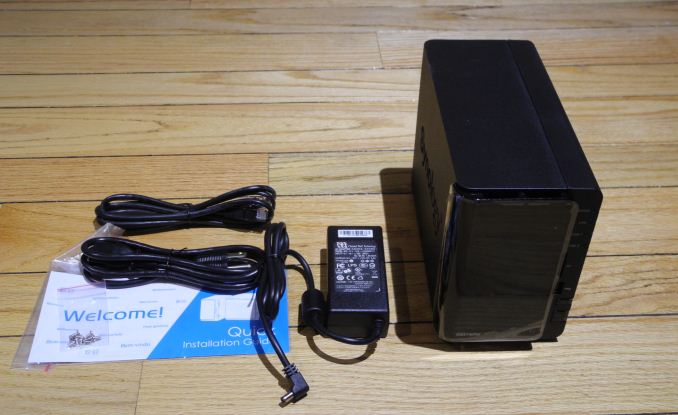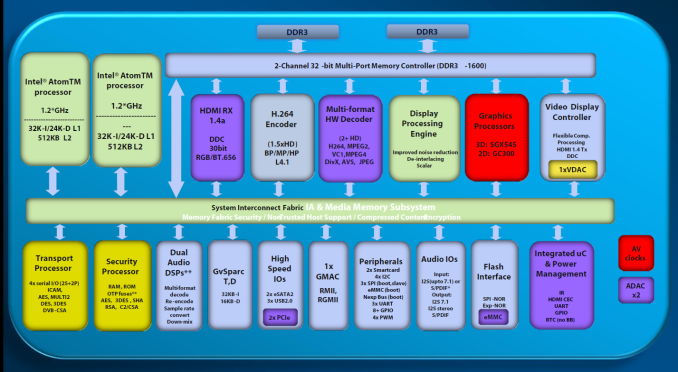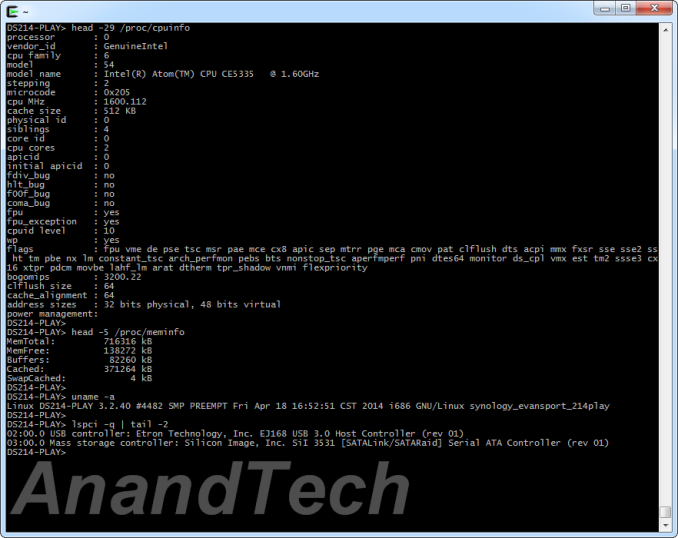Synology DS214play: Intel Evansport Almost Done Right
by Ganesh T S on May 20, 2014 3:00 PM ESTHardware Aspects & Usage Impressions
The industrial design of Synology's 2-bay NAS units hasn't really changed since we last reviewed one in the DS211+. We continue to have the detachable face-plate (a fingerprint magnet) and hot-swap bays (with the hard drives kept in place on the caddies with screws on the side). The contents of the DS214play package are as below:
- Synology DS214play chassis
- 2M Cat 5E Ethernet cable
- 65 W external power supply with US power cord
- Getting Started guide
- Screws for hard disk installation
In terms of external I/O, we have a SD card slot and a USB 2.0 port in the front panel. On the rear, we have two USB 3.0 slots, an eSATA port and a single RJ-45 GbE port. The eSATA port can be used to attach a DX513 5-bay expansion module to provide a total of 7 bays. An important aspect to remember is that the hard drives in the expansion module can't be used for volume expansion, but additional volumes only.
Platform Analysis
The block diagram below gives the layout of the Intel CE5335 SoC. Typically, x86 NAS units come with dual network ports (capable of port trunking), but units based on Evansport (such as the DS214play) don't have that because of the lack of support in the platform. This is acceptable, considering that the unit is supposed to cater to home consumers who want to use it as a media server.
The other important aspect is the available high-speed I/Os. In a NAS platform based on the CE5335, there are two SATA ports and two PCIe 2.0 lanes. There is no native USB 3.0 support in the SoC. Therefore, the DS214play's USB 3.0 support definitely from a USB 3.0 to PCIe bridge. Since the two SATA ports are already being used for the drive bays, it can be inferred that the eSATA port is enabled using a PCIe to SATA bridge. Considering these inferences, it looks like the platform should be able to support all peripherals at full speed (except for the two USB 3.0 ports which talk to the SoC through a single PCIe lane). One option to determine the components on the board would have been disassembling the unit. Fortunately, Synology provides SSH access. The screenshot below exposes some of the hardware aspects of the DS214play.
As expected, the USB 3.0 ports are enabled by the Etron EJ168A USB 3.0 to PCIe bridge, while the eSATA port is enabled by the Silicon Image SiI 3531 SATA to PCIe bridge. TechPowerUp also has a great teardown of the NAS in their review, where they show these components on the board (in addition to the Realtek RTL8211E GMAC for the GbE port and the Genesys Logic GL836 SDIO to USB 2.0 bridge for the SD card slot). A look back at the CE5335 block diagram shows that we have three USB 2.0 ports in the SoC. Only two get used, one for the SD card slot and the other for the front USB 2.0 port.
Setup & Usage
After connection to the network, the unit obtains a DHCP address (even in diskless mode) and could be setup using the web UI at http://<DS214play-IP>. The setup process is straightforward. At least one of the bays needs to be populated. We chose to use the Synology Assistant tool to initialize the NAS (we have used the web interface before in our previous Synology reviews). The firmware (Synology Disk Station Manager - DSM) can be uploaded from a local file in this process. Basic network settings (DHCP / manual static IP) can also be set up using the tool. After a restart, the rest of the configuration is handled through the web interface.
Upon logging into a freshly installed DSM, the user is provided with various options to aid in setup of external access to the NAS. Synology allows its users to create a MyDS account on their servers. The NAS units themselves are provided with a unique 'QuickConnect' ID. A MyDS account can have multiple QuickConnect IDs associated with it. The combination of this ID and a MyDS account helps Synology operate a relay service for access to the NAS from an external network. Users can opt to not register for these, but still enjoy external access if they forward the appropriate ports on their router. We will cover more on this in a later section.
DSM 5.x, in keeping up with the previous versions, is undoubtedly the gold standard to which all other NAS interfaces must measure up to. The combination of a desktop-style interface and a multi-tasking UI with support for desktop widgets make it a pleasure to use. Backing up the eye-candy is a rock-solid Linux-based storage management system and a wealth of applications (both Synology-created and third-party developed). Exploring all the features of DSM 5.x deserves a separate piece by itself. However, we will take a slightly different approach. In one of the later sections, we will look in detail into the external access and multimedia features of DSM 5.x (an area where the DS214play is supposed to excel). We have some more Synology reviews in the pipeline and those will be used to look at the other features.
Our testing sequence started with the insertion of a single disk and configuring it in Synology Hybrid RAID (SHR). For a single disk, it is effectively a JBOD configuration, but the addition of a second disk triggers a migration to RAID-1. While migrating to the new RAID level on the DS214play, the data remained online (as expected) and the process got done without any hitch. We tested RAID-1 rebuild by yanking out a disk during operation and re-inserting it. The rebuild process was also uneventful. On the whole, we were very satisfied with the unit's handling of storage operations (including handling of disk failures).





































45 Comments
View All Comments
bznotins - Tuesday, May 20, 2014 - link
Maybe I'm just not the target market for this kind of device, but I am always left scratching my head on the value proposition of something like this.For roughly the same price, I could build a micro-ATX rig with twice (or more) the SATA ports, a higher-power CPU, optical drive capability, and more USB/USB3 ports. Plus, the custom build could also be an additional home PC, from which you could run a Plex server, and/or host your mySQL database for XBMC.
I always find myself reading AT reviews on NAS boxes with the idea that I might want one. Then I look at the price and compare to the functionality of my current W8.1-based home server and the two aren't even in the same league.
Power consumption can't be it (my W8.1-based home server consumes 31W at long idle).
Network throughput can't be it (I get 900Mbps over my home network moving files between PCs).
Redundancy, perhaps?
/shrug
ZeDestructor - Tuesday, May 20, 2014 - link
Don't worry, you're not alone.I'm at the other end of the spectrum myself: I have a pile more data, well into the 6/12disk segment, and at the price, dropping a microATX Rangeley (Avoton with more extensive crypto engine) into a backblaze pod looks like a much nicer proposition.
owan - Tuesday, May 20, 2014 - link
Completely agreed. $370 for a 2 disk setup seems absolutely absurd unless you are absolutely positive you won't need more than 3 or 4TB of space over the life of the device, and even then its hard to fathom. You can build a custom PC for that much, put a 4-in-3 hotswap bay in, and have double the hot swap space, plus future expansion options. These devices just seem so limited I cant comprehend why you'd botherSpoony - Tuesday, May 20, 2014 - link
I also don't understand. I want something other than ext4 as well. If I'm going to store lots of data long-term I want reliability to be the name of the game. I ended up building a server around a Xeon E3 with ECC memory and 6x drives. Then installing FreeBSD on it with the storage drives running ZFS. It cost similar to a midrange Synology box, but it is better in every way.I think these are for people for which the hassle of setting up and building is significant. They just want to plug it in, flick some switches on the web interface, and easily store data on the network. For that I can certainly see value, it just isn't for me.
Impulses - Wednesday, May 21, 2014 - link
The number of people that want that idiot proof NAS experience might outnumber the amount of enthusiasts that will roll their own. I don't have either, still seems unnecessary with just two PC in the house, but I know plenty of non enthusiasts and family guys that have bought a NAS like this and would never or could never go DIY. Seems like beating a dead horse to argue the value if you're an enthusiast, it's there for those that aren't or don't wanna bother just like HP & DELL desktops were for ages...robinthakur - Friday, May 23, 2014 - link
I bought one because it is easy to setup and near silent in operation and has been designed for its purpose. I previously had another NAS made by Zxyel which was a total hassle to setup and use by comparison. I struggled to justify the cost of this box initially, but I have been blown away by how user friendly Synology's DSM OS and mobile apps are and being able to easily run Drupal sites on it for internal testing is great, as is being able to backup all the Macs in the house to the time machine function. Naturally, you could build your own box, but I've done that before and it costs alot more for decent components, the case will likely be bigger and it will be noisier and it takes ages to configure just right. I actually don't use the media features I just bought it to play with them as I have a mac mini hooked up to the TV for XBMC duties but I've ended up using far more of the features than I'd anticipated, not just for file shares. The only reason I might build a physical server would be to also run AD, Exchange and SharePoint VMs for development and while it would be more capable, it would also be more hassle to maintain and more costly to build (RAM and processing requirements) and most of that can be done in Azure now. The box is really user friendly and to be honest these days, that's what I want rather than spending days of my expensive time assembling a server.DanNeely - Tuesday, May 20, 2014 - link
The main advantage of small soho NASes is size and idiot proofing. You might not care about having another tower case sitting in your network closet, geek cave; but Joe Mundane would much rather have a really small box than a big one and these sort of systems can offer much better performance than a USB drive hung off a router. They also require much less skill to configure and operate than a full fledged server PC.Solandri - Tuesday, May 20, 2014 - link
This. These things look bad from a financial aspect if you're thinking of purchasing one as an individual where you undervalue your time.. But in terms of a business, you can burn through $370 in an hour, if not a few minutes. You can spend 5 minutes to buy this and 10 minutes to set it up when it arrives and get it up and running. Or you can spend an hour picking out and ordering the parts for a custom box, then spend an hour assembling it, then 2 more hours installing software, setting it up, and testing it. Usually at that point a business has burned more money on labor than it would've spent on this one-stop solution.Case in point, one example where it makes sense as an individual is if I want to set up my parents with a NAS. I don't want to remotely troubleshoot it and have to babysit them through fixes every time something goes wrong. I want it to be dirt simple to set up, and have a proven track record of reliability without continuous monitoring and management. The time it saves me from having to fix or tweak it at my parents' house can easily be worth $370 to me.
The custom box solution is only cheaper if you put little or no value on your time. (Which isn't necessarily a bad thing. I <i>enjoy</i> tweaking with and trying out new things on my custom NAS. I just wouldn't enjoy it if I had to do it remotely at my parents' house every time they have a weird problem they can't fully explain to me, or if I were paying someone $30/hr to do it.)
Beany2013 - Tuesday, May 20, 2014 - link
On a related, and wider note....I have the ability to build a seriously nice HP Microserver with encryption, trascoding streaming, and all that good stuff, too - and it'd cost the same, more or less, as one of these devices, if you don't include my time at chargable rates. I'm a multidisciplanary IT admin/troubleshooter - I'm the sort of person who can singlehandedly build an entire office infrastructure including GPO'd domain (or Puppet'd Linux environment) from scratch given the funding and a few days of time. So I'm not niave about this.
But after a ten hour day of fixing servers and workstations, I wasn't in the mood to build one on any given night of the week or weekend, so just bought the DS214+
Admittadly, no transcoding (the Play wasn't available at the time, and the DS713+ was a bit much for my needs and budget), but handily, Chromecast and VideoStream do that nicely using my laptop as a proxy.
Does everything I need to, very nicely, with absolutely sod all maintenance or tweeking required, it'll happily WOL and sleep, can talk to UPS/Wireless/Bluetooth dongles if you get the right ones, and has enough commonality with ARM Linux (it's Debian on ARM) to have a good developer pool for unapproved apps. My next project is to set up Asterix on it and practise with VOIP, too see if I can help reduce the office phone bill.
You're paying for the convenience, the simplicity and the support (that you'll rarely need with this class of device); I'm finding more and more cases where these devices are 'good enough' for a lot of SOHO and small SMB clients, and also power users such as ourselves. The nice thing about Synos range is that they scale up to monster, gazillion disk, 10GBe rackmount devices, too - all with the same interface; very handy for support purposes.
Consumer NAS devices are at the stage where they can, in many cases, replace a light use Windows/Linux whitebox/OEM server for a lot of people. Simple as that. They aren't suitable for everything, but they are suitable for a hell of a lot.
I'm not paid by Synology (or anyone in that respect) but when I find a device or service I think is worth kudos, I'll wax on about it happily. The Syno gear is worth investigating IMHO, it's a cut above the Netgear/WD/QNAP stuff, and unless you require device specific functionality (realtime replication between boxes like what the netgears do) I'd go for Syno stuff every time these days.
lyeoh - Wednesday, May 21, 2014 - link
I set up a custom RAID10 NAS at work and it's configured to run SMART tests on the drives, monitor temperatures of the drives etc and send email alerts if there are problems. Took some time to set up but doesn't need any babysitting. Why would it? It's been running year after year. Earlier this year it sent email alerts when the server room air conditioner broke down and the drives started to get warm. Probably the only machine in the entire server room that sends out such alerts ;), I set it up because the crappy WD NASes others set up were slow and kept dying or hanging.